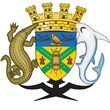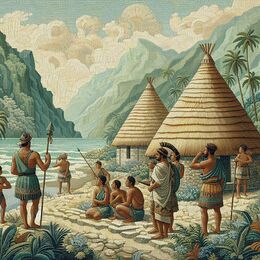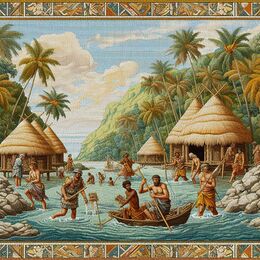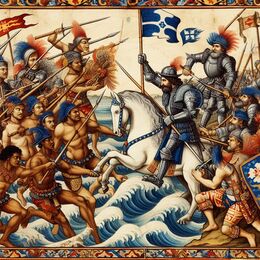Jusonia Islands: Difference between revisions
mNo edit summary |
mNo edit summary Tag: 2017 source edit |
||
| Line 173: | Line 173: | ||
[[Category:Islands]] | [[Category:Islands]] | ||
[[Category:Pelaxia]] | [[Category:Pelaxia]] | ||
[[Category:Catenias]] | |||
Revision as of 12:25, 17 March 2024
Islas Jusonias (Pelaxian Catenias) | |
|---|---|
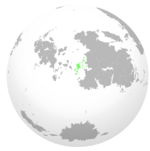 Jusonia Islands in the Kindred Sea | |
| Major cities | Fuentealba |
| Languages | Pelaxian; Insuo Loa |
| Type | Provinces of Pelaxia |
| Population | |
• 2027 estimate | 15,868,400 |
| GDP (nominal) | 2027 estimate |
• Total | N$D 555,394,000,000 |
• Per capita | N$D 35,000 |
| HDI (2027) | very high |
| Currency | Real |
The Jusonia Islands are one of the 29 confederated jurisdictions of the Pelaxian Republic, located in the west Kindreds Sea and part of the Catenias region. This province boasts a captivating geography marked by pristine coastlines, verdant landscapes, and the rugged majesty of its lone mountain range. As a province within Pelaxia, the Jusonian Islands hold a distinctive status, embodying both Pelaxian heritage and the unique identity forged by centuries Loa immigration.
Etymology
The name "Jusonia Islands" finds its roots in ancient Loa language, where "Huson" translates to "East." This linguistic origin pays homage to the geographical location of the islands, situated to the east of the Kindred Sea. The designation "Jusonia" reflects not only the islands' directional orientation but also embodies their historical and cultural significance within Pelaxian heritage.
History
The Caphirian explorers first mapped them around the 710s and established coastal settlements that quickly became autonomous as they were very far away from the metropolis., created settlements that would come to be cities such as Fontantez. This period of the archipelago is defined for the incapacity of Caphiria to maintain a direct sea and trade link with the islands, mostly because of the disruption from south kosali tribes and civil unrest in the valley.
By the 1100s most of the settlements would fall under the administration of the Duchy of Albalitor. This administration would be cut short by the invasion of the Savrian kings from mainland Pelaxia as they had started expanding all over southern Pelaxia. It was in this period that the capital of Jusonia Mayor would be consolidated. By the 1200s the islands would start to suffer from chronic raids carried by Loa people who had established a foothold well into the Kindred Sea.
The War of the Tides, spanning from 1330 to 1350, stands as a significant chapter in the history of the Kindred Sea. This conflict primarily revolved around the strategic control of the waterways governing access to and from the sea. The principal instigator, the Duchy of Albalitor, sought to secure vital maritime routes in service of the Despote of Cognata, seated in Albalitor. The despotate aimed to attain greater autonomy in managing trade, diminishing reliance on the Caphiravian Republic.
The focus of the conflict lay in the geopolitical maneuvering to control key ports and sea routes. The Duchy of Albalitor, under the auspices of the Despote of Cognata, perceived dominance over these maritime arteries as essential for economic self-sufficiency. The Loa Confederation, who maintained ties of vassalage with the archipelago through the chiefdom system, with the Krasoa Islands , resisted external attempts to control the vital waterways. This made the Jusonia Islands, a midway point into continental Sarpedon a very converted position to secure.Unified under the leadership of their esteemed high chief, Kahu'i Marakatu Loa, the Loa Confederation fought fiercely to safeguard what was deemed “ancestral lands and maintain autonomy against external encroachment.
The Jusonia Islands quickly became a sub-theatre of the war being fought around the Krasoas. Noteworthy engagements, such as the Battle of Bahía Creciente in 1335 and the Siege of Marisport in 1342, marked the tactically intricate nature of the war. These military endeavors were characterized by maneuvers to secure or disrupt maritime access points. The overarching objective was the establishment of control over ports and channels facilitating trade within the Kindred Sea. The War of Tides concluded in 1350 with a negotiated peace treaty. While the Despote of Cognata retained certain territorial claims as the newly found “Comarca de la Crasoa” and "Comarca de Juson" as enclaves further enforcing the presence of the Pelaxian and Caphiravian culture in the Kindred Sea.
Geography
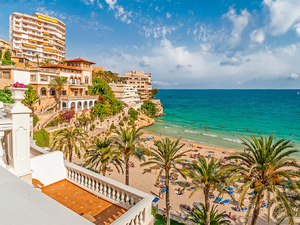

The Jusonia Islands, a picturesque archipelago nestled within the azure waters of the Kindred Sea, boast a diverse and captivating geography that beckons explorers and travelers alike. At the heart of this enchanting archipelago lies Jusonia Mayor, the largest island and a veritable jewel in the crown of the Jusonian landscape. Rising majestically from the cerulean depths, Jusonia Mayor is home to the archipelago's only mountain range, where rugged peaks and verdant valleys intertwine in a breathtaking display of natural beauty. Stretching across a vast expanse of longitude from north to south, the Jusonia Islands showcase a remarkable diversity of climates and ecosystems. In the northern reaches, closest to the equator, pristine beaches fringe the shores of lush, tropical islands, where swaying palms and vibrant coral reefs paint a vivid tapestry of color and life. Here, the sun-drenched landscapes are alive with the vibrant hues of exotic flora and fauna, creating an idyllic paradise for sun-seekers and nature enthusiasts.
As one journeys southward through the archipelago, the landscape gradually transitions, revealing a kaleidoscope of temperate forests, rolling hills, and meandering rivers. The central islands, characterized by their gentle terrain and mild climate, offer a tranquil retreat for those seeking respite from the hustle and bustle of urban life. Here, verdant valleys and fertile plains provide a fertile backdrop for agriculture and rural life, while charming villages and bustling market towns dot the landscape, evoking a sense of timeless tranquility.
Further south, the islands give way to rugged coastlines and dramatic cliffs, where the mighty waves of the Kindred Sea crash against weather-beaten shores. Here, towering sea cliffs and rocky promontories rise defiantly from the tumultuous waters below, offering a stark contrast to the serene beauty of the northern islands. Amidst the wild beauty of the southern islands, intrepid adventurers can explore hidden coves, secret caves, and windswept moors, where the timeless rhythms of nature reign supreme.
With its diverse landscapes, rich biodiversity, and captivating natural beauty, the Jusonia Islands stand as a testament to the awe-inspiring power of the natural world. While jaguars no longer roam these lands, the islands are home to a fascinating array of wildlife, from medium to large lizards that bask in the sun-drenched cliffs to a myriad of snakes, pythons, and bird species. Among the most iconic inhabitants of the Jusonia Islands are the medium to large lizards that inhabit the rocky outcrops and sun-soaked shores, from the strikingly patterned iguanas to the elusive monitor lizard. In addition to the lizards, the islands are also home to a diverse collection of snakes, including pythons and serpents that slither through the undergrowth in search of prey.
Amidst the lush vegetation and hidden glades, a variety of small mammals, from monkeys swinging through the trees to elusive rodents and dwarf deer.
Marcas
Demography
The Jusonian Islands, located right off the Pelaxian coast and in the easter corner of the Catenia insular region, have long been a melting pot of diverse cultures, ethnicities, and migration patterns. From the indigenous ethnic Loa communities to the influx of Pelaxian explorers since the 1100s, the demographic composition of the Jusonian Islands reflects a “point of frontier” where Vallosi culture and people meet the latin sarpedonic civilizations.
The Jusonian Islands are home to various ethnic Loa communities, who have inhabited the islands for centuries. The Loa people, practitioners of the Loa religion and culture, have a distinct identity characterized by their spiritual beliefs, customs, and traditions. They have lived in harmony with nature, preserving their ancestral lands and passing down their cultural heritage from generation to generation. They attest for 40% of the ethnic makeup of the population currently living in the islands. The Loa community has been historically divided by two religious branches: the Loa Traditional and the Loa Catholic. The demographic composition of islands has been shaped by consistent migratory movements, particularly among ethnic Loa communities and Pelaxian nationals. The migration patterns have been influenced by various factors, including economic opportunities, political instability, and cultural exchanges. The ethnic Loa communities have historically engaged in transitory migrations, moving between different islands within the Jusonian archipelago in search of fertile lands,chiefdom expansion, resources, and spiritual connections.
Since the 1100s, the Jusonian Islands have witnessed the gradual settlement of ethnic Pelaxians, primarily from the Duchy of Albalitor and the Savrian Kingdom. The Pelaxians established coastal settlements and trading outposts across islands, contributing to the economic and cultural development of the region. These settlements brought new technologies, fauna, agricultural practices, and trade networks to the region, facilitating economic growth and cultural exchange especially around the highest point of expansion during the Carto-Pelaxian Commonwealth and the Southern Route to Audonia. During this period the islands became a key strategic hub for ships that brought products from Vallos and Audonia as well as slave labor from Daxia. Daxian slaves also played a crucial role in shaping the cultural landscape of the islands, infusing elements of Daxian language, music, cuisine, and religious beliefs into the local communities, thus becoming 12% of the island’s demographic makeup.
Politics
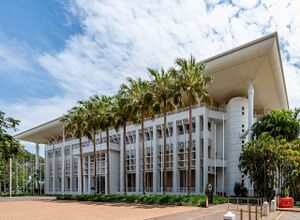
The politics of the Jusonian Islands offers a case study in decentralized governance and island autonomy. Governed under the umbrella of the Federal Republic of Pelaxia, the Jusonian Islands are characterized by a provincial parliament, executive governorship, and a provincial supreme court.
Comprising several islands, the electoral landscape of the Jusonian Islands is governed by democratic principles, with regular parliamentary elections held every five years to elect representatives to the provincial parliament. Utilizing a proportional representation system, the parliamentary body, composed of elected members from various constituencies, plays a pivotal role in shaping legislative agendas, debating policy matters, and overseeing executive functions.
The parliament is empowered to enact laws, scrutinize government actions, and allocate resources. The executive branch is headed by a governor, elected by the parliament, who serves as the highest-ranking official responsible for implementing policies and administering public affairs. Additionally, a provincial supreme court, comprising esteemed judges appointed based on merit and legal expertise, safeguards the rule of law and upholds justice across the islands' jurisdiction.
Political Parties
Movement 18 de Febrero: Founded after the island revolt of February 18th of 1879, this party advocates for island autonomy and separatism while at the same time supporting provincialization of key industries and services and control of provincial resources.
- Democratic Party: As the oldest active political party in the country, the PD follows a Christian democratic philosophy and is the founding party of the modern state apparatus. It currently operates as a socially centrist and economically right-wing party.Often associated with latin-pelaxian supremacism and centralization from Albalitor.
- Augustist Party: Rooted in the principles of Augustism, this party promotes national sovereignty, cultural heritage, and traditional values. Foundational party of the 20th-century democratic process, historically representing a third-way, big tent ideology. It promotes economic pragmatism oriented towards national sovereignty and autonomy, advocating for a market economy with active state participation as a mediator between different political-economic agents. It advocates for local governance, emphasizing the importance of law and order, patriotism, and social cohesion with continental Pelaxia.
- Social and Labor Movement: The MSO is a left-wing party that emerged from the economic crisis of the early 21st century. Its main expansion and growth occurred during the government of Pedro Meireles, advocating for a productive revolution in Pelaxia towards a stable and mixed model of a social market economy.
- Jusonia First / Liga de Defensa Nacional: A nationalist party that prioritizes the interests of the Jusonian Islands above all else, Jusonia First advocates for policies that promote local prosperity, cultural preservation, and environmental stewardship. It seeks to assert the sovereignty of the Jusonian people and safeguard their unique identity and heritage, with heavy xenophobic tendencies and being supported primarily by latin-pelaxian supremacists over other ethnicities of Jusonia.
Economy
The economy is based primarily on tourism, which makes up 32% of the GDP. The Canaries receive about 12 million tourists per year. Construction makes up nearly 20% of the GDP and tropical agriculture, primarily bananas and tobacco, are grown for export to Europe and the Americas.
Agriculture
In 2029, the value added from agriculture, fishing and forestry combined made up approximately 16.1% of Jusonía’s GDP. 60% of farm products are exported. Irrigation is an important and widespread practice for a country where many parts receive low rainfall. Agriculture, forestry and fishing was the second-strongest industry from 2023 to 2025, with the number of employees growing from 295,495 in February 2023 to 325,321 in February 2025.
Cereals, oilseeds and grain legumes are produced on a large scale in the biggest islands such as Jusonia Mayor for human consumption and livestock feed. Wheat is the cereal with the greatest production in terms of area and value to the Jusonian economy. Sugarcane, grown in the most northern islands, is also an important crop; however, the unsubsidised industry is struggling to compete with the huge and much more efficient continental sugarcane industry.
Ecologists are concerned that the resources, especially in the more arid islands, are being overexploited but there are still many agricultural resources like tomatoes, potatoes, onions, cochineal, sugarcane, grapes, vines, dates, oranges, lemons, figs, wheat, barley, maize, apricots, peaches and almonds.
Fishing
The fisheries in the archipelago is a very large scale industry. The islands produce many species of wild caught fish such as tuna and other schooling fish.
Manufacturing
Shipbuilding and Repair
The Jusonian Islands are a significant player in the global shipbuilding industry with 38 registered shipyards in 2031 distributed in Jusonia Mayor, María and Motún. As of 2032, it is the largest shipbuilding province by gross tonnage.Cargo vessels are exported to countries where shipping operators are based. Bulk carriers, container ships and big passenger ferries are built in the country's shipyards. Surrounded by waters, the country has abundant natural deep-sea ports ideal for development as production, construction and repair sites. In the ship repair sector, the PELMAR complex in Jusonia Mayor is expected to accommodate 96 vessels for repair. Shipbuilding is part of Pelaxia's maritime heritage,employing over 600,000 people and contributing almost 15 percent of revenues to the ocean-based industries.
Mining
The Jusonias are rich in mineral and geothermal energy resources. In 2029, it produced 1,928 megawatts (2,585,000 hp) of electricity from geothermal sources (7.55% of total electricity production). A 1989 discovery of natural gas reserves off the island of Jusonia Menor is being used to generate electricity in three gas-powered plants. Gold, nickel, copper, palladium and chromite deposits are among the largest in the world.Other important minerals include silver, coal, gypsum, and sulphur. Significant deposits of clay, limestone, marble, silica, and phosphate exist.

